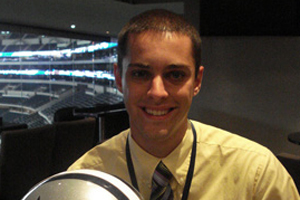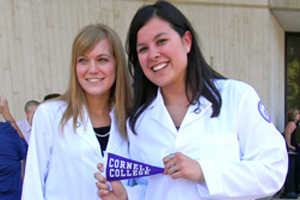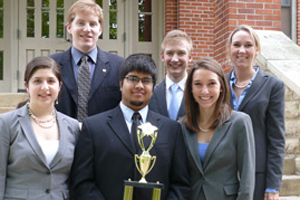Extraordinary campaign redefines Cornell Education
It all began with something we at home sometimes call a honey-do list, those onerous and inevitable fixes for our nests that multiply and attach barnacle-like to our pocketbooks and defy any notion of predictability—especially when old buildings are involved.
Outwardly the picture of health, a historic showcase of red brick, weathered stone and welcoming porches, in some corners of Cornell College the insides were beginning to resemble trampled doormats. College insiders knew this was a list that would take more than honey to fix.
But while peering into the potential black hole of fixes, some undaunted alumni also saw opportunity. Using the creative and critical thinking that Cornell instilled in their brains once upon a time, they began to craft extraordinary opportunities of an academic kind.
Thus, the Extraordinary Opportunities Campaign was born.
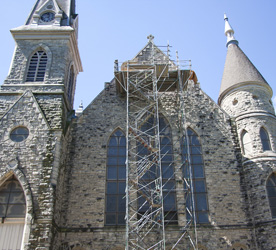
While scaffolding and sawdust covered the campus, the Berry Center, Dimensions, and other campaign-inspired academic programs were born, offering eager students block-length or longer learning experiences unique in the academic world.
As One Course At A Time’s offerings multiplied, the honey-do list was whittled down.
King Chapel’s iconic peaks, shaped by 56-foot long trusses, hand milled and heaved overland from a mill in Clinton, were now nearly 130 years old and shrunken with age. Like a wool cap run through a drier, the roof’s span was, in some places, falling short of protecting outside walls from water. And that’s the short explanation.
The rooms on the list? There were many, in some cases adding up to entire buildings. Pfeiffer Hall, a classic when it opened in 1930, was now in need of entirely new mechanical systems, and a fresh floor plan, including classroom space, and a design that could compete with today’s residence hall trends.
The Commons, its orange carpet a living room to students, had been freshened a bit not long ago. But still, it carried overtones of a Brady Bunch house, and the family it housed was only getting bigger. With a year of record enrollment and plans to grow, the 1960s town center of campus was going to need an overhaul.
In Old Sem, more of the same. Things were getting a little too cozy for optimal functioning. The alumni and college advancement staff moved into a renovated Rood House, now the Paul K. Scott Alumni Center, opening up space for more student services. The former Wade House Admission Center had two interview rooms. More than two interviews at once, and Vice President of Enrollment Jonathan Stroud had to give up his office. Now the Luce Admission Center, the renovated and expanded admission headquarters offers a more appropriate all-important first impression.
Building academic advantages
Such was the list of what had to be done. But looming just as high as King Chapel’s towers was a desire “to leverage the college’s distinctiveness,” said then-president Les Garner, referring to the college’s distinctive One Course At A Time block plan.
A campus can be so beautiful, so modern, so full of flat panel TVs and organic cafeteria food that it can make young hearts swoon. But don’t underestimate the savvy of young people (and their parents who are paying the bills) in an increasingly competitive world of higher education. For the serious students, the ones Cornell attracts, academic ingenuity and life-changing opportunities are still revered for the lifetime of doors they will open. Programs like the Berry Center, Dimensions, and the Fellows program, brain children of the Extraordinary Opportunities Campaign, are Cornell’s foothold from this day forward.
“The campaign was very successful in many ways, including the creation of innovative programs like Cornell Fellows, Dimensions, and the Berry Center. These initiatives, and the way they strengthen the fabric of the college, will continue to make a lasting difference for Cornell students for many, many years,” said John McGrane ’73, the board of trustee’s chair-elect.
So when Cornell began its Extraordinary Opportunities Campaign in 2004, it was not a quest for quick fixes. It was the mobilization of a mission to bring the campus up to date and position it for tomorrows. It was a mission with an estimated price tag of $92 million, far more than Cornell had ever sought.
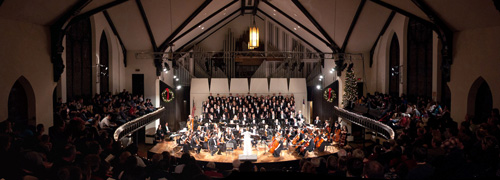
Fearless leadership
Enter John Smith ’71. Asked if he would accept this mission, in its lead role as campaign chair, the Cornell trustee, president and CEO of CRST International, and a fearless force in the corporate world, had to give it some thought. The $92 million price tag had caused him to pause.
Smith, who joined his father in the family trucking business after graduating with an MBA from the other Cornell (University) and who helped grow CRST from a $25 million annual revenue company in 1974 to one that will hit the $1 billion mark in 2011, wouldn’t go so far as to say he was pessimistic.
But still.
“It just seemed unreachable in some respects,” Smith recalled.
And that was even before the college knew a pothole was ahead—a recession likened to the Great Depression.
Leap forward six years. It’s Oct. 16, 2010, the dawning of a Saturday on homecoming weekend. By midmorning, sunlight filtered golden through the canopy of Hilltop trees, decked out in their best fall finery. Alumni lingered in chatty packs, comparing technicolor memories as leaves drift to the ground around them. The former students strolled, crunching through unavoidable piles of fallen leaves, pausing to snap photos of the scaffolding that scaled the front of King Chapel.
By the afternoon, they cheered even as the Rams lost to Buena Vista. And by that evening, at the alumni dinner and campaign celebration at the Cedar Rapids Marriott, more jubilation, much louder cheering.
On stage, John Smith (now chair of the Board of Trustees), and Vice President of Alumni and College Advancement Peter Wilch ’94 made drumroll references to what they were about to reveal. The crescendo gained in suspense. Then boom, campaign total flashed on a screen.
Not $92 million. No, instead, $105.8 million, the highest ever for a national liberal arts college in Iowa.
“When it flashed across the screen people were pretty surprised,” said trustee Gilda Vinzulis Boyer ’84, who with husband Barry Boyer ’84, contributed $50,000 toward the campaign. It was the class of 1960’s reaction that Gilda loved most. Five decades removed from their own student experience, they were vocally overjoyed by what the campaign’s outcome means for today’s students. “It was kind of fun to have them whooping and hollering in the banquet hall,” Boyer said.
Of the final tally, $4.6 million had come from their own class.
Fate, faith, and purple ties
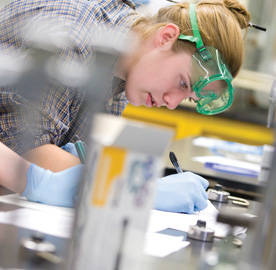
Just how did it happen that a college devoted to the expensive task of keeping its campus historic, paired with a fervent desire to make its academic programs among the nation’s most unique, managed to miss the recession’s pothole and burst past the finish line, breaking a record to boot?
It’s complicated, of course. But condensed to some best moments, let’s just say the active ingredients included, but are not limited to: fate, faith, purple ties, a campaign and trustee board that was teaming with dreams — and John and Dyan Smith, with their moxie — and their private jet.
Fate first: Richard Small ’50 and wife Norma donated more than $20 million to the campaign but have over the years donated more than $40 million to the college that gave Richard his beloved wife, and the liberal arts savvy to carry him forth as a champion in the business world.
A member of the campaign steering committee and former chair of the board of trustees, Small was just a 17-year-old in May of 1946, about to graduate from high school. In study hall one day he asked the classmate ahead of him if he was going to college. “Yes,” said Campbell McConnell (who did graduate from Cornell in 1950 and went on to write the world’s most widely read economics textbook). “To Cornell College.” To which Small said, “Maybe I’ll go there too.”
Faith: A Cornell student experience fosters friendships, the resulting diploma officially attaches you to a family tree. Families look out for one another. In the end, nearly 60 percent of alumni donated to the campaign, $150,000 was given by graduating seniors, and 23 commitments were for $1 million or greater.
Purple ties? They are the ubiquitous hallmark of Cornell’s staff. Peter Wilch, explaining his job to his son’s kindergarten class on career day, boiled his role in the $92 million campaign this way: “I help organize parties. I make sure the Web page works well. I ask people for money. And I wear purple ties. Any questions?” A girl in the front row raised her hand excitedly. “Yes?” Wilch asked. “I like your shoes,” she said, admiring his wingtip tasseled loafers.
Which brings us to the jet: Shoe leather takes fundraisers on the personal visits that are so essential to building donor relationships. But jets. Well, they speed things up a bit.
John and Dyan Smith donated $5 million to the campaign and spent countless hours challenging other alumni to pitch in too. Smith, Garner, and former vice president of alumni and college advancement Terry Gibson ’59 were frequent fliers on Smith’s CRST jet, a favor from Smith that saved valuable travel time.
Gibson had developed wonderful relationships, Smith said. Garner, Smith recalled, was eloquent and concise, taking the enormous list of wants and needs and condensing it to a pocket companion for donors. Smith was brought along to make the ask.
“His leadership was essential, and he’s never seen an ask he couldn’t make,” Garner said.
By the numbers
- $105.8 million raised
- Largest campaign by a national liberal arts college in Iowa
- 8,338 donors to the campaign
- 57 percent of alumni donated
Campaign giving
- 38 gifts of more than $500,000
- More than $1.5 million given by 50th reunion classes
- More than $150,000 given by graduating seniors from five classes through the Senior Challenge
- More than 40 programs created or enhanced by gifts during the campaign
Campaign gifts breakdown
- Cash: $45,853,737
- Pledges: $25,897,851
- Deferred: $34,079,069
Campaign gifts by source
- Alumni: $86,112,323
- Friends: $7,244,912
- Foundations: $6,148,203
- Parents: $4,154,433
- Corporations: $2,001,934
- Church: $168,852
- Total: $105,830,657
Campaign gifts by type
- Unrestricted: $27,338,030
- Restricted: $14,540,593
- Endowment: $33,750,660
- Annuities: $1,608,948
- Plant: $28,592,426
- Total: $105,830,657
Given by sitting Trustees, Life and Honorary: $50,245,684
Given by sitting and retired Trustees, Life and Honorary: $62,105,56
Redefining Liberal-Arts Education
For now, with the campaign goal surpassed, a mountain has been scaled and the view on the other side is breathtaking. On campus, faculty and scholarship endowments have been fortified, buildings reinforced. In classrooms, new programs leverage the block plan’s schedule with countless off-campus study opportunities and an infusion of on-campus programming and career guidance. In this way, Smith said, Cornell has “redefined liberal arts education.”
To Wilch, who took the campaign helm in 2006, the outcome already has been “transformative, elevating the college to a new level, in reputation and academic opportunities for our students. We aspire to educate and prepare students for success beyond the Hilltop,” Wilch said. “Now we have programs that connect the dots for opportunities a Cornell education can provide.”
But to junior Diego Verdugo, born in Mexico and the first in his family to go to college, Cornell’s campaign has been life changing.
He needed Cornell’s generous financial aid to be able to attend college at all. That financial aid included a gift from the Frank K. Whitson Memorial Scholarship, a $2.5 million estate gift made to the campaign in 2008 by Lee and Dorothy Whitson, whose son, Frank, graduated from Cornell in 1970 and died of leukemia in 1974.
In a single-page thank you letter to Dianne Polasik, Whitson’s fiancee at the time of his death, Verdugo says a thank you to her, in words that could universally apply to every campaign donor.
“… Thanks for giving people like me the opportunity to look for a better life. I couldn’t express with words the gratitude I feel towards you and it is for that reason that I choose to express it with actions, being active, keeping a good GPA, working hard after school, and keeping my aspirations high. May God bless you and your family for even though you may not realize it, you are angels fallen from the sky. I pray to God that someday I can reach the point where you are now and I also can make dreams come true.”
Brought to Cornell by his persistence and the college’s faith in his potential, don’t be surprised if one day Verdugo is a guy with a purple tie (or two), a jet, a checkbook like Richard Small’s, and the heart and loyalty to match.

